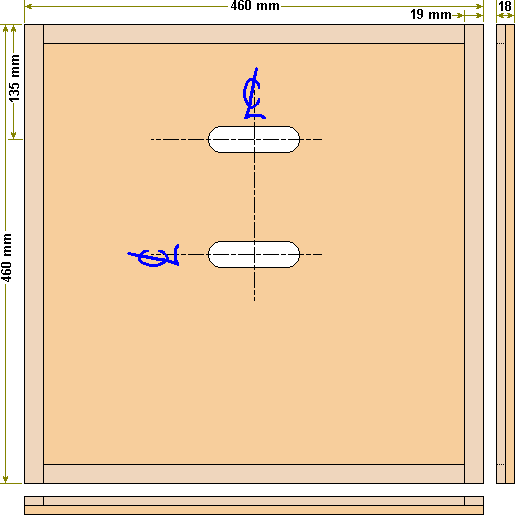Clearer Boards
Uniting Bees
|
|
|
|---|
|
Clearer Boards Uniting Bees |
National Bee Hive 'Crown Board' or 'Coverboard'
|
|---|
|
The crown board is a method of closing off the top of a bee hive so that the main protective roof can be easily removed. The Grain should run along the longest dimension of any part. |

|
|---|
Cutting of parts (all dimensions in mm).
| Qty | Length | Width | Thickness | Material | Usage |
|---|---|---|---|---|---|
| 1 | 460 | 460 | 9 | Exterior Plywood | Main Panel |
| 2 | 460 | 19 | 9 | Pine | Long sides of rim |
| 2 | 422 | 19 | 9 | Pine | Other rim parts |
 Use with the rim downwards for bottom bee space or with the rim uppermost if top
bee space is required.
Use with the rim downwards for bottom bee space or with the rim uppermost if top
bee space is required.
The holes shown are to suite the standard porter escape.
Porter Escape Holes gives methods of cutting such holes. For normal use a single 33 mm central hole proves to be adequate.
Note 1.
9 mm plywood is specified owing to it's
greater rigidity and freedom from warping. This durability outweighs
the small cost saving of using thinner material.
Note 2.
9 mm is specified for the thickness of the rim material, but
commercial supplies are often of 8 mm thickness, using 8 mm is unlikely to cause
any problems.
Assemble using a waterproof PVA type glue and 16 mm pins or staples.
Many old specifications for this item quote a rim depth as small as 6 mm. In practice this causes much trouble due to brace comb that has been inadequately cleaned from the upper surface of the top bars.
Versions of this board will be found with bee space on both sides of the main panel. Many commercially available types use this method with the panel fitted into rebates in specially machined rim pieces. There is no benefit in having this reversible bee space... It has only become common as it is a simple way of stiffening a 6 mm plywood panel and thus keeps down production costs.
The version as drawn above is both simple and durable. If petroleum jelly is used on the rim and linseed oil is used on the main panel the item will give many years of good service.
Written... Summer 2000, Revised... 19 May 2002, Upgraded... 01 December 2005,
|